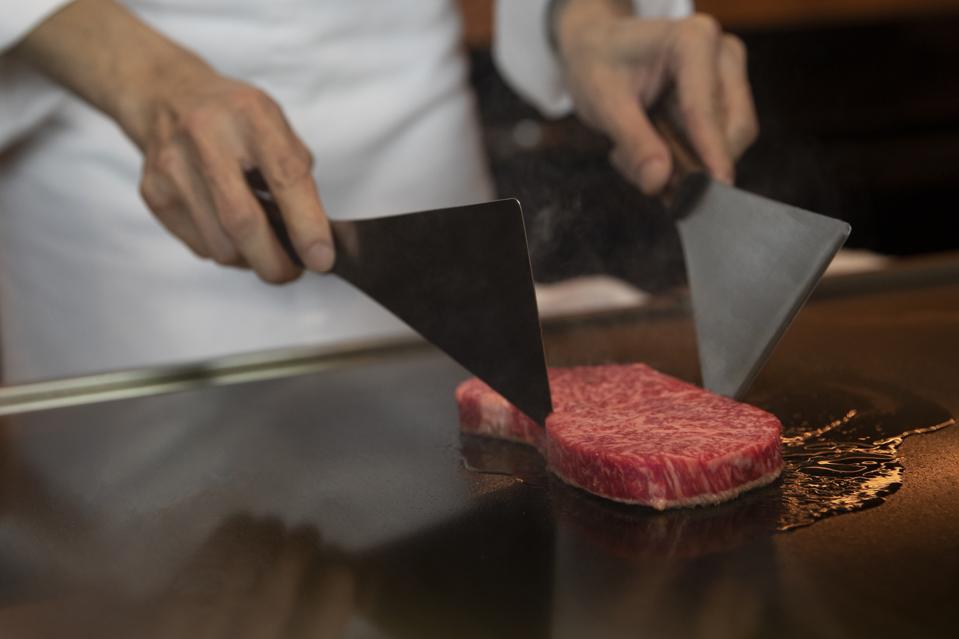From spectacular street food to elite tasting-menu destinations, Singapore is full of bucket-list dining experiences. Chef Tetsuya Wakuda’s Michelin-starred Marina Bay Sands restaurant Waku Ghin, with a cavalcade of luxury ingredients and thoughtful cooking at its chef’s table, might be the pinnacle.
Start at the bar and get a seasonal fruit cocktail or mocktail with Japanese musk melon, Thai golden mango or Malaysian passionfruit for a refreshing welcome. Then head into the intimate chef’s table space for a meal that’s truly all killer, no filler. There might be king crab, lobster and wagyu that are dramatically presented and then cooked in front of you. There might also be generous portions of bonito tataki, chutoro carpaccio and grilled nodoguro. There are no throwaway courses here.
This is about a lot more than over-the-top ingredients. Wakuda is an ace at weaving in seasonal ingredients to build peak flavors as he showcases different cooking techniques. Nodoguro is accompanied by Okinawa spinach and sudachi to add brightness, acidity and earthiness. A pan-seared filet of ayu comes with a pomelo salad and water pepper vinaigrette for a little hit of sweetness and tartness.
Game-changing little details abound. King crab is steamed and served with lemon-scented olive oil. Lobster is broiled with tarragon. Wagyu, served with fresh wasabi and citrus soy, is rolled to ensure every bite is optimal.
Wakuda is at the Waku Ghin on the night we visit. He discusses how everyone uses caviar now and how he’s long looked for ways to layer caviar into dishes. It’s about creating food that’s simultaneously rarefied and balanced. Waku Ghin’s signature dish of marinated botan ebi with uni and caviar tastes as revelatory as ever, and so does its cold capellini with uni, caviar and truffles.
Sweetness, brininess, texture, temperature. Everything is carefully calibrated here, including the sake and wine pairings. Masuizumi Platinum Nama is a light and fruity junmai daiginjo that enhances the umami of fish. It’s also an exclusive sake label created specifically for Wakuda. Clos du Mont-Olivet Châteauneuf-du-Pape, full-bodied and deeply French, is harmonious with shellfish and richly marbled beef.
For dessert like an excellent dark chocolate souffle and beautiful petit fours, you’re moved into a parlor. From there, you can see stores, including an Hermès boutique that actually has Birkins on display like museum pieces that you probably have no chance of purchasing. Luxury on top of luxury. That’s the essence of Marina Bay Sands.
Singapore contains multitudes, of course, so there are also no-frills bucket-list experiences. In Geylang, Sin Huat Eating House (a restaurant with no website and no printed menu) is where chef/owner Danny Lee personally cooks crab over mounds of bee hoon. It’s a singular noodle dish, with every strand of the rice vermicelli soaking up crab juices and aromatics. Singaporean street-food guru KF Seetoh first took us here 15 years ago. Sin Huat (a favorite of everyone from Anthony Bourdain to Ferran Adria) hasn’t lost a step since.
If you want more frills and thrills at dinner, chef Dave Pynt continues to work his live-fire magic at the world-renowned Burnt Ends. Pynt cooks whole fish and steaks over coals at his Michelin-starred destination. He celebrates his Australian roots by bringing in ingredients like marron, which is freshwater crayfish that resembles lobster but is a touch sweeter. He puts caviar over coarse beef tartare and also over smoked quail eggs.
Pynt’s famous bangers also include brioche toast topped with both crab and a generous dollop of uni. The dining room at Burnt Ends is moody and loud and fun as guests drink Old Fashioneds and big Australian reds. There are spit-roasted marshmallows for dessert. This is a total-package modern barbecue restaurant.
Of course, you shouldn’t visit Singapore without eating hawker-stand food. So this time around, Seetoh takes us to the Geylang Serai market and hawker center, which is chock-full of soul-warming Muslim food. We eat mutton biryani and stingray and beef rendang and prawn donuts and oxtail soup and a Malaysian take on Hainanese chicken.
You can check out Seetoh’s Makansutra site and e-book for an incomparable overview of Singapore’s hawker stands and its gloriously diverse array of vendors. Seetoh has, of course. famously coined his own phrase for bucket-list meals. It’s called “die die must try.”

